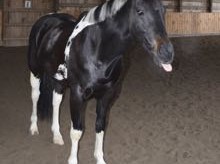(If you haven’t already, read the August 1 blog first.)
Several people have written to tell me that they’ve also had a hen literally burst from maggots. We’ve all shared that same sense of guilt. How could one of our doted-on hens harbor such horrors without us knowing? I still can’t find anything written about hens with maggots in their vents. However, myiasis (the techincial term for maggot infestation) or “fly strike” as it is called in England, is well-known by sheepherders and other farmers.
Here’s why it seems to come on so suddenly – once the fly lays her eggs on the moist tissue, it only takes 20 hours for them to hatch. The maggots go through three larval stages, and with each one the clump of maggots increases in mass exponentially. Within three days you can have a cluster of maggots the size of a tennis ball in your hen.
The important thing to understand (and an area of much misinformation) is that although the flies will lay their eggs on a moist area, that the maggots themselves need dead flesh to eat. (Which is why maggots are used medicinally. For example, they clean-up gangrened flesh, but not the part that is healthy.) Diarrhea is a symptom not a cause of maggot infestation. Therefore, worms which cause loose stools are not a cause of maggots, and worming your flock will not help save your hen (although if you do have internal parasites, you should certainly worm your flock!) It might be that if you check your hen the moment you see runny manure, that you can catch the problem soon enough to save your chicken. But, I think that the real problem is an internal injury that you can’t see until it is too late.
Of all the people who have written to me, only one has managed to save her hen. Diana has an alpaca farm and a small flock of hens. Like me, she noticed a hen with diarrhea and set her aside in isolation until she could bathe it later that day. That evening, Diana was shocked to discover a gaping wound filled with maggots. She flushed the area with warm water and betadine and used her finger to pry out the maggots. She then applied antibiotic cream several times a day. Diana also syringed water down the hen’s throat to keep her hydrated. She didn’t feed the hen, so that there wouldn’t be fecal matter passing down the cloacae to dirty up the area. That lucky hen is still alive a year later.
My afflicted hen, Perrie, had too much internal damage to save. I didn’t want to prolong her suffering. Difficult choice. But if you keep hens long enough, you’ll face this if not other crises. I’m glad that my writing about this very unpleasant topic has made a few of you feel less alone in these decisions. One hencamer lost her son’s favorite hen to this very problem just yesterday. If I hadn’t blogged about maggots, she would have blamed herself. Hopefully, I won’t have any more such stories to tell in the near future. But if I do, I’ll tell you about it.

